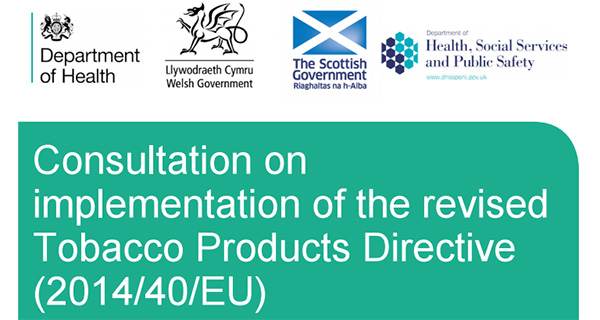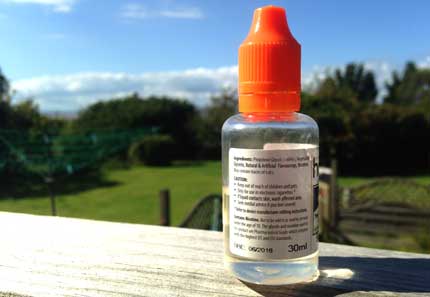
The UK government is consulting on how to implement EU e-cig regulations, and you have the chance to let them know what you think.
While the UK can only influence limited areas of the TPD, some of the changes they want to make are crucial for the survival of the UK e-cigarette industry. Given that everyone has a limited amount of time, I’ve put together a brief guide to the TPD, highlighting the most important areas to respond on.
If you’re wondering whether it’s worth responding, the UK government so far has proved to be a stark contrast to both the EU and the Welsh government.
The cross party parliamentary group’s attitude towards e-cigs and e-cig businesses has been reasonable, open and supportive, and there’s a very good chance your response will be taken into account.
Rather than cover everything, I’ve focused mostly on the key points that are likely to have the largest effect on vapers.
I’m also no legal expert.
So if you’ve read the post and have a different interpretation from me, please do let me know in the comments on this blog - I’ll be monitoring these and often edit blog posts based on readers’ helpful comments and suggestions.
Remember, you can read the whole document here. Regulations on e-cigarettes start on p.22.
To reply, you can fill in the online survey here.
Or by downloading the form from here (scroll down until you see 'Ways to Respond'), and emailing your response to: [email protected]
I’ve divided this post into key points for those who are short of time, and more comprehensive points for those who are interested.
Key Points from the TPD
 I’ve tried to do this in order of importance, on the basis that not everyone is going to get through all these points!
I’ve tried to do this in order of importance, on the basis that not everyone is going to get through all these points!
Q15 and 16 - Authorisation or Notification
The government has two options.
- Require suppliers to request authorisation before releasing new products.
- Require suppliers to supply notification (probably to the MHRA) six months before releasing new products.
The UK government is currently minded to support 2, which is the least bad choice out of two bad choices.
A six month notification period will undoubtedly massive slow down the pace of innovation and make bringing new products in a slower, more painful and expensive process. However, it’s better than the alternative (handing over control of e-cig products to the MHRA!)
 Q23 - Should retailers and importers be given the proposed transition period until May 2017 to sell through old stock?
Q23 - Should retailers and importers be given the proposed transition period until May 2017 to sell through old stock?
The TPD comes into force in May 2016.
But many of its terms and definitions have not been explained, and are unlikely to be explained until shortly before the TPD comes into force.
Let’s consider:
- It will take time to invent new TPD compliant products.
- We won’t have any time before the TPD comes into force to invent and produce new products.
- Even after we have the new products, we will have to notify the government SIX months before it comes into force.
So it is absolutely crucial that we support this proposal, which will give us one year to continue to sell existing products after the TPD comes into force in May 2016.
Q22 - Should the Government charge the industry proportionate fees to recover costs associated with the TPD2?
These are likely to be huge (there is no accurate estimate yet).
It is unlikely the austerity government is going to cough up for cost of the EU’s ridiculous legislation. However, we already know that dozens if not hundreds of smaller e-cig business will be destroyed by the TPD - each additional cost will lead to more businesses going under. So if you want choice, the answer should be no.

Q21 - This question deals with the warnings that should be on packaging. There is a choice of:
a. "This product contains nicotine which is a highly addictive substance."
or
b. "This product contains nicotine which is a highly addictive substance. It is not recommended for use by non-smokers."
The government is minded to accept the second.
I don’t have a problem with either warning in principle - but have they seen how much information we need to include on an e-liquid bottle? Already you almost need to include a magnifying glass to see the warning.
(Perhaps not surprisingly, as the EU essentially transposed the regulations from tobacco cigarettes to e-cigarettes. That’s why you see instructions such as place warnings on front and back of a pack. A bit difficult with a round e-liquid bottle!)
I don’t know how much room the UK government has to change the warnings, but given space considerations perhaps the following would make more sense:
"Contains nicotine. Highly addictive. Not for use by non-smokers."
Section 5.58 - MHRA
The government is planning to make the UK MHRA the authority for regulating e-cigarettes.
While this is not queried in the document, I have been able to get it added to the next discussion in the parliamentary group.
Here’s why the MHRA would be a bad regulator:
- The authority has twice tried to ban electronic cigarettes.
- The authority is dominated by the pharmaceutical industry (which pays its costs, provides its staff and also, in some cases, pays additional salaries to staff). The same pharmaceutical companies produces quit smoking aids which have been hit hard by the success of e-cigs and has campaigned hard against e-cigs.
- The MHRA is designed to regulate pharmaceutical products - not consumer products.
If you write to the parliamentary committee, and you share my concerns, please share it in your letter.
Q11 to 14 - Cross Border Sales
The TPD gives the government the option of banning cross border sales. If the UK allows this, there will need to be an age verification system put in place.
The document states that in the UK most people can’t buy e-cigs online if they are over 18 as they need a credit card, but this is unlikely to be the case for all EU countries.
Based on my interpretation, most companies will have to put in place an age verification system IF they continue to sell to the rest of the EU, but not if they restrict sales to the UK. However, there doesn’t seem to be a common age verification system across the whole of the EU.
(As with the EU cookie law, it seems to be another example of a law being written before the technology is available to comply with it.)
For most companies, I think cross border sales will not be realistically achievable, but for those interested, the government is consulting on:
- Whether to nominate an individual to be responsible for verifying products comply with provisions in UK regulations before supplying products to consumers?
- Whether cross border sales of e-cigarettes and refills should be prohibited?
- What systems are available to verify customer ages across the EU?
Additional Points
Q17 - Definition of electronic cigarettes
Should electronic cigarettes be called electronic cigarettes and clearomiser/cartomisers refill containers?
This might seem a dumb question (and the government is not currently planning to change the definition). However, an interesting point raised in the parliamentary meeting the other week is that the very name of our vaping devices has held back their acceptance by the anti-tobacco lobby.
